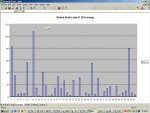Loony BoB
International Captain
I was just reading the above post by Swervy and started thinking about how one would go about finding some kind of stats that could give an idea bout how reliable a batsman really is. I personally think if you want to check a batsman's consistency/reliability, it's best to go by something besides the average as one hefty innings can save a batsman's average after a fair few bad games. Of course, medians don't take into account not-outs... I was just playing around with this and wondered what would happen if I 'raise' the median by one innings for every not-out. This left me with these results (as examples):Swervy said:have a look at Afridi's last 50 ODI's batting figures, i think it kind of shows what I mean about him not relying on form, but more luck to be honest:
83,35,4,5,5,56,0,108*,14,1,40,18,1,3,14,33,13,26,62,27,0,31,0,6,4,55*,4,30,0,8,13,16,0,17,1,6,9,80,6,3
In those 50 innings, the best spell of double digit scores is 6 in a row,and that only included two scores of over 30.
If the hitting comes off, then great...but it is so rare that it just isnt worth Pakistan risking playing him
Cairns
Tests: 41.5 (last 24 innings including 2 NO's)
ODI's: 29 (last 47 innings including 8 NO's)
Afridi
Tests: 15 (last 25 innings including 1 NO)
ODI's: 13 (last 49 innings including 1 NO)
Dravid
Tests: 72.5 (last 26 innings including 5 NO's)
ODI's: 49 (last 44 innings including 9 NO's)
Sehwag
Tests: 34 (last 26 innings including 0 NO's)
ODI's: 26 (last 50 innings including 3 NO's)
Unfortunately it turns out it didn't work so well with Glen McGrath (I had to test a bowler)... with his last 26 innings, he has 13 NO's and therefore his top score of 21 for tests came into play! I'm not sure on what I'd do if someone had over half of their innings with NO scores - which is what McGrath did with his ODI's - I just ended up using his top score. Of course, in the 2003 World Cup, I'm pretty sure Dravid or Tendulkar finished with an average higher than their high score since they had so many NO's, too, so I guess there's a fault in everything. Oh, if you're wondering...
McGrath
Tests: 21 (last 26 innings including 13 NO's)
ODI's: 11 (last 50 innings including 27 NO's)
Comparing these with averages (in order of highest to lowest, obviously only for the stated matches)...
Test Averages: Dravid (82.71), Sehwag (54.5), Cairns (50.22), Afridi (32.5), McGrath (10.23)
Test Medians: Dravid (72.5), Cairns (41.5), Sehwag (34), McGrath (21), Afridi (15)
ODI Averages: Dravid (43.85), Sehwag (35.4), Cairns (31.17), Afridi (22.85), McGrath (4.08)
ODI Medians: Dravid (49), Cairns (29), Sehwag (26), Afridi (13), McGrath (11)
So, er, to make a topic - how do you rate people when it comes to reliability and consistency? Do you think averages truely reflect such things? If not, do you think you can help find a way to show who is truely consistent/reliable? Oh, and also, does anyone else here play around with stats, or am I just a freak? Can you tell that I'm bored? I think it's probably about time I got to bed, huh? Yeah, I'm going to bed soon... late nights make me do strange things.






